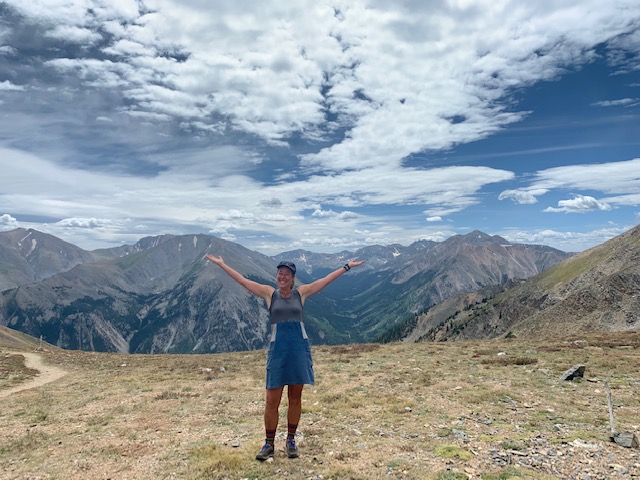How I prepared for a sub-100 day thru-hike of the Continental Divide Trail
Let’s get something out of the way right up front: this post is not about the newest “biohacks”. Rather, it’s about the “basics” and how to build a strong foundation. These are the strategies that, if applied consistently, will give you the health you need to take on any adventure (chronic illness or not).
At least that’s been the case for me. I’m all for tactics, such as intermittent fasting, cold thermogenesis, infrared sauna, ketosis, etc., but if you haven’t mastered the basics, don’t waste your time or money on the other stuff.
By focusing on the concepts outlined below, I’ve become a stronger backpacker than ever before.
My Story
My outlook after I was diagnosed with Hashimoto’s and adrenal fatigue was bleak. I’d built my identity as a long distance runner and backpacker. My self worth directly correlated to the number of miles I ran or hiked each day.
After returning from the PCT in 2014 and discovering that all the symptoms I was experiencing were due to adrenal fatigue and an autoimmune thyroid condition, life got pretty dark for a while.
I felt disconnected from my life and my body. Extreme fatigue had become the norm. My hair was falling out in clumps. I was gaining weight with no change in diet or exercise. I was depressed and listless.
On top of the physical and mental symptoms from my illness, I was grappling with losing my identity as a ‘young, fit, endurance athlete’. I was running 10 miles daily and had been a vegetarian for over 15 years. I believed I was the definition of health. I knew it was a waste of mental energy, but I couldn’t help but fall into the ‘why me?’ mindset.
To make a long story short(er), I tried every trick in the book to get my health back: different diets, supplements, exercise routines, and protocols. My healing journey felt like I was taking two steps forward and one back. My progression towards wellness was far from linear, but there was indeed progress, even if it was subtle. Slowly I found my way out.
I’m not fully healed, but I’m strong enough to do what I love again: walk and run long distances in the wilderness.
Fast Forward to 2019
I’d been dreaming of this hike since before I got “sick”. Most thru-hikers complete the CDT in 4-5 months. My goal was to complete a sub-100 day hike. I needed to know that all the work I’d done on my health was worth it. My goal was to not just get out there, but to truly crush it.
I wasn’t trying to be that ‘young, fit, endurance athlete with flawless health’. Rather, I wanted to demonstrate that with a commitment to true self care, that I could hike as well or better than I had pre-illness. In turn, I hoped it would serve as inspiration for anyone else struggling with their health; those who felt like their adventure dreams were out of their reach.
But first, I needed evidence that these strategies worked. I didn’t talk about my goal much before my hike because, honestly, I didn’t know how it’d go.
I completed the 750-mile Oregon Desert Trail (ODT) in the fall of 2018 and felt great, but my pace wasn’t as aggressive as what I had planned for the CDT. Holding it together for 1 month on the ODT was one thing; holding it together for almost 3 ½ months on the CDT was quite another. Did I really have the health to do this when the memories of not even being healthy enough to run a few miles were still fresh in my mind?
Thru-hiking is for EVERYONE (if you’re willing to put in the work)
Good health and fitness don’t just come naturally to me. I work for it. It’s a commitment and a priority. I work to be at my healthiest because it’s imperative for engaging in what is most important to me (getting outside) and for living fully.
There’s a stereotypical image of what a ‘thru-hiker’ looks like: mid-20’s, fit, white male (with long beard and short shorts). That’s not me. But I’m just as competent of a hiker.
I say that not out of hubris, but simply to remind you that there’s a place at the table for everyone. I also don’t mean to imply that competition, or a certain speed, or high mileage days, “should” be the goal. That was my goal because it was a proxy of health for me. And because I like to push my physical limits. It’s how I connect with the wild, externally and internally.
Adventure Ready is on online course designed to help you optimize your physical health so you can take on your next adventure with confidence. You’ll learn to master your mindset, find the ideal diet for YOUR body, develop a training plan that won’t result in overuse injuries, increase your energy, and much more!
The Method
Here’s how I built good health and prepared my body to perform optimally on a 3000 mile hike. These strategies will work, whether you have a chronic illness or if you’re just looking to be at your healthiest so you can get into the outdoors with confidence.
Master Your Mindset
First things first. It starts with what goes on in your mind. This applies when it comes to adventures, but in truth, it matters for anything in life.
I learned this lesson very clearly while hiking on the Appalachian Trail in 2009. I joined a friend for the start of his thru-hike, thinking I might thru-hike too, if it worked out. Nope. This is the wrong mindset with which to embark on any epic undertaking; particularly one which will require you to overcome challenges. When my off-trail life went haywire, I left the trail. I don’t regret the decision, but the point is that I hadn’t fully committed to thru-hiking. If I had, I would’ve found any way possible to make it work. Any obstacle can be overcome if you’ve committed and you know your desired outcome very clearly.
Action: Before your next adventure, write down your desired outcome and include 1-2 sentences about WHY you’re taking it on.
Dial in Your Perfect Diet
Pushing your body to the limits and maintaining the energy for 35+ mile days is much easier when you’re eating the right diet. I don’t suggest that there’s one single best diet for everyone, but you do need to figure out what works for your body. This is true for everyone, but it’s especially important with a chronic illness because the ‘wrong diet’ for your body could lead to a lot of inflammation.
For the endurance athlete, inflammation can impact performance and compromise immunity. The physical strain of hiking long days is already creating some degree of inflammation in the body, so limiting excess inflammation coming from other sources is important.
Action: For information on eating a lightweight, nutrient dense trail diet, check out this free course.
Prioritize Sleep
Perhaps the most underappreciated of the health pillars is sleep. Prioritizing sleep is HUGE. Research shows that “sleep disruption is associated with increased activity of the sympathetic nervous system and hypothalamic–pituitary–adrenal axis, metabolic effects, changes in circadian rhythms, and proinflammatory responses. In otherwise healthy adults, short-term consequences of sleep disruption include increased stress responsivity, somatic pain, reduced quality of life, emotional distress and mood disorders, and cognitive, memory, and performance deficits.”
Action: Maintain a consistent sleep time. Stay off screens at least an hour before your planned bedtime (blue light disrupts melatonin production). Aim for 7+ hours per night.
Optimize Gut Health
“All disease begins in the gut.” Hippocrates nailed it. Microbiome research is one of the hottest areas of research, with recent findings revealing that gut health has implications in a wide variety of diseases including obesity, diabetes, irritable bowel syndrome, inflammatory bowel disease, depression, and cardiovascular disease. For the long distance hiker, good gut health means better immunity, increased absorption of essential nutrients, decreased inflammation, and increased motivation, to name a few of the many benefits.
Action: Include plenty of probiotic-rich fermented foods (kimchi, sauerkraut, kvass, etc.) in your diet. Feed those probiotics their favorite food: soluble fiber. Think oats, beans, citrus, apples, lentils, and peas. Consider a professional-grade supplement (click here for 10% off).
Keep Stress in Check
Despite the research that’s piling up showing the negative impacts of stress, and even the World Health Organization (WHO) pointing to stress as the primary health epidemic of the 21st century, I dismissed the real impact of stress for a long time. In doing so, I’d unintentionally put a limit on how much my body could heal.
Stress not only creates hormone disruption and systemic inflammation, it can impact focus, memory, gastrointestinal function, and the cardiovascular system, to name just a few of it’s wide-ranging impacts.
Could this invisible force really be impacting my overall wellness that much? After fixing my diet, my training, my sleep, and my gut health, and still struggling with some lingering symptoms, it was apparent that I needed to address any other factors that could be at play. It’s an ongoing practice, but when I prioritize joy and keep a watchful eye over where stress is seeping into my life, I’m noticeably happier and healthier.
Action: Ask yourself, “What are all the ways, small and large, that stress has seeped into my life? More importantly, what can I do to eliminate or mitigate it?”. Some of the methods that work for me include a morning journaling practice, meditation, running, walking in nature, baths, and calling people I care about.
Train Your Body
This strategy comes last because it matters, absolutely, but if all of the above is not in place, a good physical training plan can only take you so far. I tend to maintain a decent base fitness level year round through hiking, running, HIIT workouts, and yoga. Other than a few longer weekend hikes, I didn’t do too much extra training for the CDT.
Depending on where you’re starting from, everyone’s physical training plan will look slightly different. In general, start low and slow, and build up from there.
Action: Develop an appropriate individualized training plan. To avoid injury, it’s important to assess where you are now and build up fitness gradually. You can work with a trainer or enroll in our Adventure Ready course for guidance on how to assess your current fitness, find potential weak spots, and build a training plan that will get you ready for your hike without injury.
It may be cliche at this point, but it’s been my experience that our greatest struggles turn out to be our greatest lessons. That’s certainly been true for my journey as an endurance athlete with an autoimmune illness. I wouldn’t have asked for it, but it’s caused me to dive deeper than I ever would have otherwise into what it means to create true health and resilience.
We dive much deeper into these topics in Adventure Ready, an online course designed to help you up-level your physical health so you can take on your next adventure with confidence!












